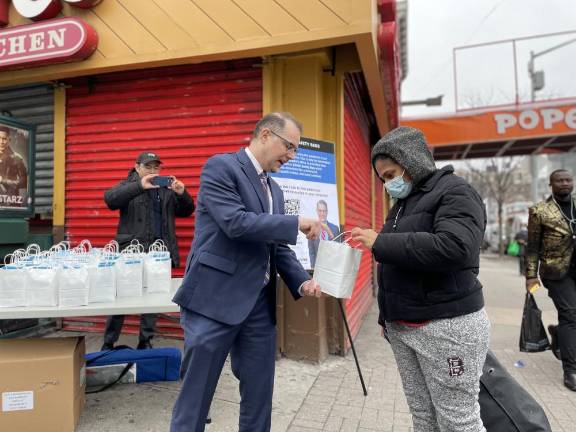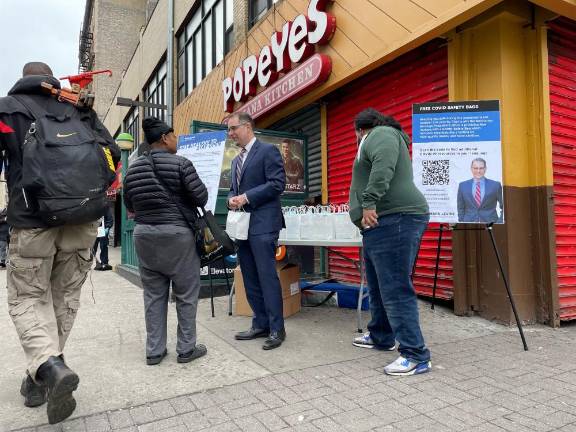“I just want to acknowledge, before we even start, the level of frustration that many New Yorkers have.”
This was Dr. Dara Kass as she opened a briefing Thursday on “preparing for the new wave of COVID.”
Back in what seems now like another age, Kass would join briefings like this one with Mark Levine, when he was chair of the City Council health committee and she was a well-known urgent care doctor.
Both their lives have changed. Now, she is the regional director of the United States Department of Health and Human Services and Levine is borough president of Manhattan. But COVID is still with us.
“We didn’t think at that time that in 2022 we would need to continue to do those types of Q and A‘s,” Levine said as he welcomed Kass back. “But alas this virus had different plans.”
“I am frustrated like many of you that we still need to do this,” Kass added. “That there are still questions that we have. There are still policies that don’t feel even across the board. Or people want to know why is this affecting me or what do I need to do now? I’ve done so much already.”
Kass said she aired this frustration – or maybe COVID fatigue would be an apt characterization – right at the start of the conversation to reduce the risk that our judgments will be distorted by our aggravation. “I try to let go of that.”
We may feel the pandemic is just endless and unrelenting. Yet the truth, as Kass makes clear, is that much has changed. This is not March of 2020. We have knowledge and we have tools, if we use them well.
Take testing. Levine recalled his first case of COVID-19 (“I just can’t be left out of any wave”) at the start of the pandemic. “It’s hard to remember but testing was in really, really short supply in those early days,” Levine recalled. In any case, “the doctor said there is no point in getting a test because if you’re positive there is nothing we can do for you. If you have respiratory failure get yourself to an ER. Otherwise just rest.”
That was then. Now, we have so many tests that it is important to distinguish which ones to use, Kass explained, and if you do get infected there are multiple treatment options. So you should move quickly to determine which you might need.
TESTING
At first there barely were any tests and so the country flew blind into the pandemic. Then the PCR test became the state-of-the-art and there was concern that the so-called rapid tests weren’t accurate enough.
But now, says Kass, the view is that PCR tests are, if anything, “often too sensitive for what it means to live our lives now” and the rapid tests are just accurate enough to tell you when you might be infectious and a risk to others.
Which was when Levine asked Kass if it was “actually a thing” that people with symptoms of COVID were testing negative on the rapid tests.
“That’s your immune system at work,” Kass explained. “That’s your immune system really fighting off that virus before you have enough measurable virus in your system to have that test turn positive. Fortunately, when that rapid test is still negative, even if you’re symptomatic, it is unlikely that your contagious.
“That’s the great warning sign of this version of COVID,” Kass added. “Sometimes it’s seasonal allergies. And sometimes its just another cold. It’s not always going to be COVID.
“But if you are taking a COVID test and it’s negative and you’re having a severe sore throat; or you know somebody who has COVID; or the numbers are going up in our communities, kind of like they are now; make sure to take another test the next day or two days later. It’s that second test, if your symptoms persist, that’s often positive. And that really is that window where you’ve turned probably infectious that really gives you a chance to remove yourself from anybody in your family who might be vulnerable.”
After considerable startup challenges, rapid tests are now widely available for free. Both the city and the federal government will give them to you. Levine noted you can pick up tests at many city buildings, including clinics and public libraries.
Before the briefing Thursday, Levine went to 125th Street and St. Nicholas Ave. and distributed “COVID Safety Bags” containing at-home test kits as well as high-quality masks, thermometers, hand sanitizer and a list of community resources. He said he hoped the Adams administration would do this for the entire city.
For many people, using the rapid tests mean setting aside the lesson they learned earlier that PCR tests were better. It is true they are more sensitive, meaning they can identify even traces or fragments of virus.
“You generally don’t need to know if there is virus living in you if you’re asymptomatic or not infectious,” Kass explained.
“The reason we pivoted away from PCRs to rapid tests is more about what the test tells you about how you need to live your life ... And that’s why we stopped doing PCRs on asymptomatic people that are fully vaccinated and boosted. Because we are trying to make sure we are finding information that matters to the spread of this virus. To preventing other people from getting it.”
TREATMENT
There is a second major change. Unlike early in the pandemic, when testing was essentially a way to know how bad the pandemic was and who needed to be isolated to protect the rest of us, testing is now crucial for quickly applying treatments, particularly to those who are older or otherwise vulnerable to COVID.
“It’s really important that you’re vaccinated and boosted before you get infected,” Kass said. “But once you’re infected it’s not just Tylenol, Motrin, rest and let’s hope everything is OK. I spent the beginning of this pandemic doing a lot of telemedicine and it was very frustrating to listen to people’s concerns and give them no options. That’s not what is happening now.”
She explained that there are two main buckets of medication, oral antiviral pills and infusions of monoclonal antibodies. Testing has become vital because in both cases these treatments are far more effective when taking quickly.
“It’s pretty remarkable what they can do if taken within five days of symptom onset,” Kass said. “They are best used early in the course. Not when you feel terrible but before you feel terrible.”
The city has created a central pharmacy that on a doctor’s prescription can deliver antiviral pills to any New Yorker within hours. Some pharmacies are also authorized to conduct COVID tests and prescribe antiviral pills on the spot to those testing positive.
Mayor Eric Adams, who announced Sunday that he has tested positive for COVID, said he was taking these antiviral drugs and “encourages all New Yorkers eligible for these medications to take them as well.” He noted they were free.
WHAT’S NEXT?
Levine asked Kass the question that is on everyone’s mind: “Will this be our last COVID wave?”
“No,” she replied without hesitation.
“As long as we’re seeing new variants pop up around the world and the risk of people getting infected and transmitting new variants, we will continue to see these waves come into our communities.
“But we will be less and less vulnerable to that. We will see our protection layered. Every time we are infected and get post-infectious immunity. Every time we get a vaccine. We increase our protection and that’s really important for our community to move forward.”
Staying informed has become even more crucial.
“This is now turning into a moment where we are evaluating our own risks,” said Kass. “We know ourselves. We know our families. We know our own personal risk aversion ...We need to meet people where they are and give them the information to act accordingly.
“We are not in the same moment now that we were two years ago,” she concluded.
“We are prepared as a city to address this pandemic with knowledge.
“And with the confidence that we are going to take care of each other.”
“And I think we’re going to be ok. I really do.”
“We didn’t think [in the early days of the pandemic] that in 2022 we would need to continue to do those types of Q and A‘s. But alas this virus had different plans.” Manhattan Borough President Mark Levine

